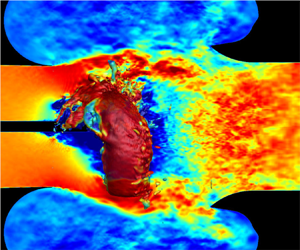Marine propellers are studied in design and off-design modes of operation like crashback, where the propeller rotates in reverse while the vehicle is in forward motion. Past experiments (Jessup et al., Proceedings of the 25th Symposium on Naval Hydrodynamics, St John's, Canada, 2004; Proceedings of the 26th Symposium on Naval Hydrodynamics, Rome, Italy, 2006) studied the marine propeller David Taylor Model Basin 4381 in the open-jet test section of the 36-inch variable pressure water tunnel (VPWT). In crashback, a significant discrepancy with unclear sources exists between the mean propeller loads from the VPWT and open-water towing tank (OW) experiments (Ebert et al., 2007 ONR Propulsor S & T Program Review, October, 2007). We perform large-eddy simulation at  Re=561\,000 and advance ratios
Re=561\,000 and advance ratios  J=-0.50 and
J=-0.50 and  -0.82 with the VPWT geometry included, contrasting to the unconfined (OW) case at those same
-0.82 with the VPWT geometry included, contrasting to the unconfined (OW) case at those same  J and
J and  Re=480\,000. We identify and delineate the water tunnel interference effects responsible, and demonstrate that these effects resemble those of a symmetric solid model or bluff body. Solid blockage due to jet expansion and nozzle blockage due to proximity to the tunnel nozzle are identified as the primary interference effects. Their impact varies with the advance ratio
Re=480\,000. We identify and delineate the water tunnel interference effects responsible, and demonstrate that these effects resemble those of a symmetric solid model or bluff body. Solid blockage due to jet expansion and nozzle blockage due to proximity to the tunnel nozzle are identified as the primary interference effects. Their impact varies with the advance ratio  J and strengthens for higher magnitudes of
J and strengthens for higher magnitudes of  J. The effective length scale to assess the severity of interference effects is found to be larger than the vortex ring diameter.
J. The effective length scale to assess the severity of interference effects is found to be larger than the vortex ring diameter.
























